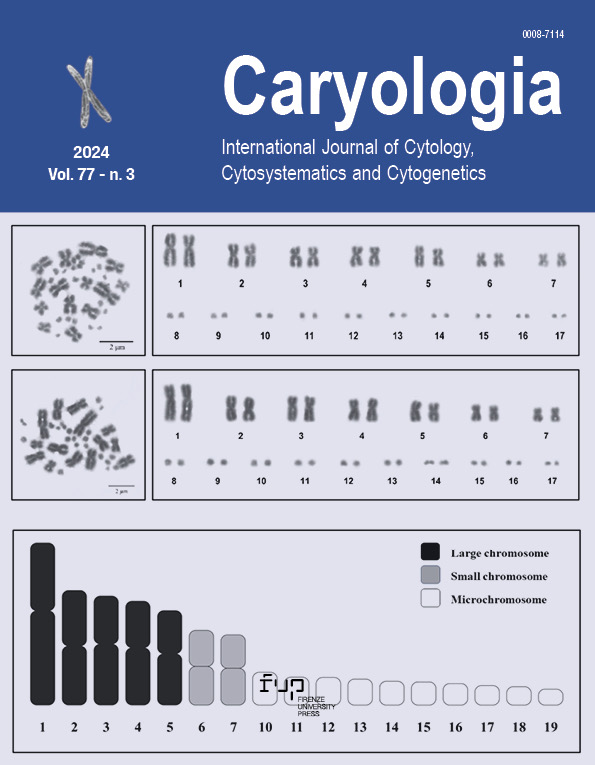Genomic in situ hybridization (GISH) and performance analysis in intergeneric hybrids from five consecutive generations of Erianthus x Saccharum
DOI:
https://doi.org/10.36253/caryologia-2727Keywords:
Erianthus, Saccharum, introgression, cytology, genomic in situ hybridization, intergeneric hybrid, sugarcaneAbstract
Erianthus arundinaceus, one of the species of ‘Saccharum complex’ has a number of important agronomic traits including good ratooning ability, tolerance to both drought and waterlogging, disease resistance and vigor and is of interest as a potential source of parental germplasm to sugarcane breeders. We report here for the first time the chromosome composition, Erianthus chromosome transmission patten and agronomical trait evaluation of Erianthus addition lines in five consecutive generations of E. arundinaceus x Saccharum. The hybridity of randomly selected clones could confirm with Erianthus Specific Tandem Repeat (ESTR) sequences. The results of classical cytology revealed that the mode of transmission of gametes, except in the second generation, followed n+n pattern whereas in second generation (CYM 07-971) it was showing 2n+n with elimination of few chromosomes. Progressive elimination of Erianthus chromosomes is observed in consecutive generations where the F1 showed 30 Erianthus chromosomes and it was ranged from 0-2 in fifth generation. Agronomical trait analysis indicates that further backcrossing with commercial clones with high juice quality or intercrossing among the selected progenies would improve both juice quality and cane traits in E. arundinaceus x Saccharum hybrids.
Downloads
References
Besse P, McIntyre CL, Burner DM, de Almeida CG. 1997. Using genomic slot blot hybridization to assess intergeneric Saccharum x Erianthus hybrids (Andropogoneae—Saccharinae). Genome 40 (4): 428–432. https://doi.org/10.1139/g97-057
Bremer G. 1961. Problems in breeding and cytology of sugar cane. Euphytica 1: 59-78.
Cai Q, Aitken KS, Fan FH, Piperidis G, Jackson P, McIntyre CL. 2005. A preliminary assessment of the genetic relationship between Erianthus rockii and the ‘‘Saccharum complex’’ using microsatellite (SSR) and AFLP markers. Plant. Sci. 169 (5): 976-984. https://doi.org/10.1016/j.plantsci.2005.07.002
D’Hont A, Rao P, Feldmann P, Grivet L, Islam-Faridi N, Taylor P, Glaszmann, JC. 1995. Identification and characterization of sugarcane intergeneric hybrids, Saccharum officinarum x Erianthus arundinaceus, with molecular markers and DNA in situ hybridization. Theor. Appl. Genet. 91 (2), 320–326. https://doi.org/10.1007/BF00220894
Daniels J, Smith P, Paton N, Williams CA. 1975. The origin of the genus Saccharum. Sugarcane Breed. Newsl. 36, 24–39.
Deng HH, Lia ZZ, Li QW, Lao FY, Fu C, Chen XW, Zhang CM, Liu SM, Yang YH. 2002. Breeding and isozyme marker assisted selection of F2 hybrids from Saccharum spp. x Erianthus arundinaceus. Sugarcane and Canesugar 1: 1–5.
Doyle JJ, Doyle JL. 1990. Isolation of plant DNA from fresh tissue. Focus 12, 13–15.
Hemaprabha G, Mohanraj K, Jackson P, Lakshmanan P, Ali GS, Li AM, Huang DL, Ram B. 2022. Sugarcane genetic diversity and major germplasm collections. Sugar Technol. , 24: 279– 29. https://doi.org/10.1007/s12355-021-01084-1
Huang Y, Wu J, Wang P, Lin Y, Fu C, Deng Z, Wang Q, Li Q, Chen R’ Zhang M. 2015. Characterization of chromosome inheritance of the intergeneric BC2 and BC3 progeny between Saccharum spp. and E. arundinaceus. PLoS ONE 10: e0133722. https://doi.org/10.1371/journal.pone.0133722
Lekshmi M, Pazhany AS, Sobhakumari VP, Premachandran MN. 2017. Nuclear and cytoplasmic contributions from Erianthus arundinaceus (Retz.) Jeswiet in a sugarcane hybrid clone confirmed through genomic in situ hybridization and cytoplasmic DNA polymorphism. Genet. Resour. Crop EvoI. 64: 1553–1560. https://doi.org/10.1007/s10722-016-0453-5
Mohanraj D, Padmanaban P. Viswanathan R. Alexandar, KC. 1997. Sugarcane screening for red rot resistance. Sugar Cane 3: 18–23.
Mukherjee SK. 1957. Origin and distribution of Saccharum. Bot. Gaz. 119: 55–61.
Nair KN, Mohanraj K, Sundaravelpandian K, Suganya A, Selvi A, Appunu C. 2017. Characterization of an intergeneric hybrid of Erianthus procerus × Saccharum officinarum and its backcross progenies. Euphytica 213: https://doi.org/10.1007/s10681-017-2053-7
Narayanaswami S. 1940. Megasporogenesis and the origin of triploids in Saccharum. Indian J. Agric. Sci. 10: 534.
Piperidis G, Christopher MJ, Carroll BJ, Berding N. D’Hont. 2000. A. Molecular contribution to selection of intergeneric hybrids between sugarcane and the wild species Erianthus arundinaceus. Genome 43 (6): 1033–1037. https://doi.org/10.1139/gen-43-6-1033
Piperidis N, Chen J, Deng H, Wang L, Jackson P, Piperidis G. 2010. GISH characterization of Erianthus arundinaceus chromosomes in three generations of sugarcane intergeneric hybrids. Genome 53 (5): 331–336. https://doi.org/10.1139/g10-010
Premachandran MN, Sobhakumari VP, Lekshmi M, Raffee Viola V. 2017. Genome characterization of in vitro induced amphiploids of an intergeneric hybrid Erianthus arundinaceus X Saccharum spontaneum. Sugar Tech. 19: 386–393. https://doi.org/10.1007/s12355-016-0482-6
Roach BT. 1989. Origin and improvement of the genetic base of sugarcane. In proceedings of the Australian Society of sugar cane technologists, Brisbane. 35-47.
Sobhakumari VP, Asmita, D. 2014. Cytogenetics and performance analysis of pre-breeding hybrids of Saccharum officinarum and Saccharum spontaneum. J. Sugarcane Res. 4 (1), 33–39.
Wu J, Huang Y, Lin Y, Fu C, Liu S, Deng Z, Li Q, Huang Z, Chen R, Zhang R. 2014. Unexpected inheritance pattern of Erianthus arundinaceus chromosomes in the intergeneric progeny between Saccharum spp. and Erianthus arundinaceus. PLoS ONE 9, e110390. https://doi.org/10.1371/journal.pone.0110390
Downloads
Published
How to Cite
Issue
Section
License
Copyright (c) 2024 V.P. Sobhakumari, K. Mohanraj

This work is licensed under a Creative Commons Attribution 4.0 International License.
- Copyright on any open access article in a journal published byCaryologia is retained by the author(s).
- Authors grant Caryologia a license to publish the article and identify itself as the original publisher.
- Authors also grant any third party the right to use the article freely as long as its integrity is maintained and its original authors, citation details and publisher are identified.
- The Creative Commons Attribution License 4.0 formalizes these and other terms and conditions of publishing articles.
- In accordance with our Open Data policy, the Creative Commons CC0 1.0 Public Domain Dedication waiver applies to all published data in Caryologia open access articles.


